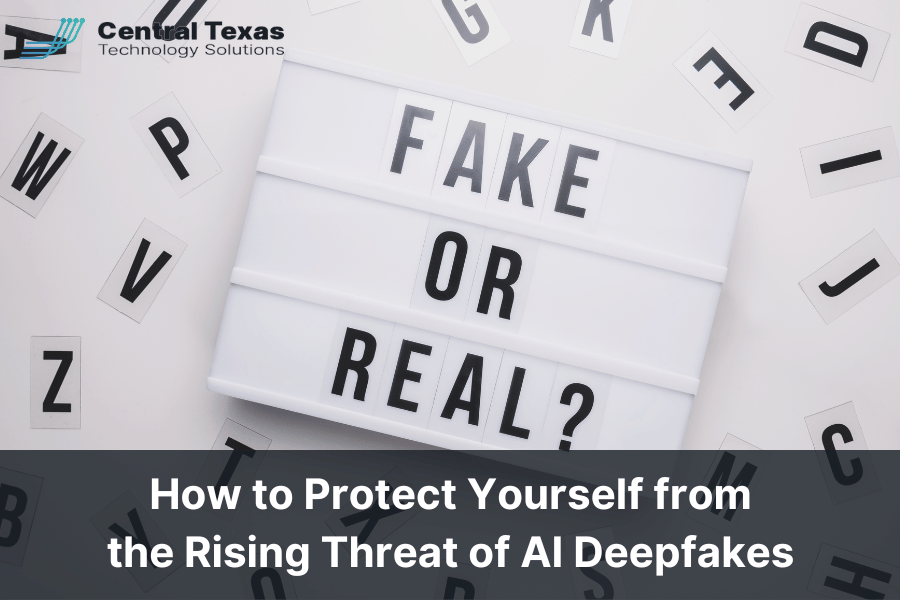
As technology evolves, so do the tactics of cybercriminals. One of the most alarming advancements in recent years is the use of AI deepfakes. These hyper-realistic, AI-generated images, videos, and sounds are being weaponized to deceive individuals and organizations, putting identities and sensitive data at significant risk.
The threat is real, but understanding and implementing strong security measures can help safeguard your personal and professional assets.
What Are AI Deepfakes, and Why Are They Dangerous?
AI deepfakes are synthetic media created using advanced machine learning algorithms. They combine real images, voices, and videos to produce content that is often indistinguishable from authentic material.
Cybercriminals use deepfakes for:
- Impersonating executives or employees to authorize fraudulent financial transactions.
- Launching social engineering attacks to extract sensitive data.
- Defaming individuals or companies with fabricated audio or video clips.
The growing sophistication of AI tools makes it increasingly challenging to spot these fakes. For organizations, the stakes are especially high, as a successful deepfake attack can result in financial loss, reputational damage, and legal implications.
Protecting Your Organization from AI Deepfakes
While the threat is daunting, there are actionable steps you can take to fortify your defenses:
1. Strengthen Identity Security Systems
Traditional authentication methods, like passwords, are no longer enough. Upgrade to phishing-resistant credentials, such as:
- Biometric verification (e.g., fingerprints or facial recognition).
- Multi-factor authentication (MFA) using physical security keys.
These methods make it significantly harder for attackers to access sensitive systems and data.
2. Implement Device-Level Security Measures
To protect against deepfake exploitation:
- Allow only authorized devices to access your company’s network.
- Regularly update software and security protocols to reduce vulnerabilities.
- Use endpoint detection tools that assess device risks in real time.
3. Train Your Team to Recognize Deepfake Tactics
Awareness is a powerful defense. Educate employees to:
- Question unusual requests, especially those involving financial transactions or sensitive data.
- Verify identities through multiple channels if something feels off.
- Look for signs of manipulated content, such as unnatural facial movements or audio mismatches.
4. Leverage AI-Powered Detection Tools
Security programs can include advanced AI tools that:
- Identify inconsistencies in images or videos.
- Detect signs of manipulation in audio clips.
- Monitor network activity for unusual behavior patterns.
Why AI Deepfake Detection Is an Ongoing Challenge
Deepfake technology is constantly improving, making detection tools a game of catch-up. Hackers train their algorithms to bypass existing detection systems, creating a digital arms race. This underscores the importance of adopting a multi-layered security approach, combining human vigilance with cutting-edge technology.
Frequently Asked Questions About AI Deepfakes
1. How can I spot a deepfake?
While advanced deepfakes can be hard to identify, look for:
- Unnatural blinking or facial movements.
- Audio that doesn’t sync perfectly with video.
- Subtle glitches or inconsistencies in the background.
2. What industries are most at risk from AI deepfakes?
Financial services, healthcare, and media are prime targets due to the sensitive nature of their data. However, any organization using videoconferencing or digital collaboration tools can be vulnerable.
3. Are there laws protecting individuals and organizations from deepfake threats?
Many countries are introducing legislation to address deepfake misuse. However, these laws are still evolving, so proactive measures are your best defense.
Contact CTTS today for IT support and managed services in Austin, TX. Let us handle your IT so you can focus on growing your business. Visit CTTSonline.com or call us at (512) 388-5559 to get started!
